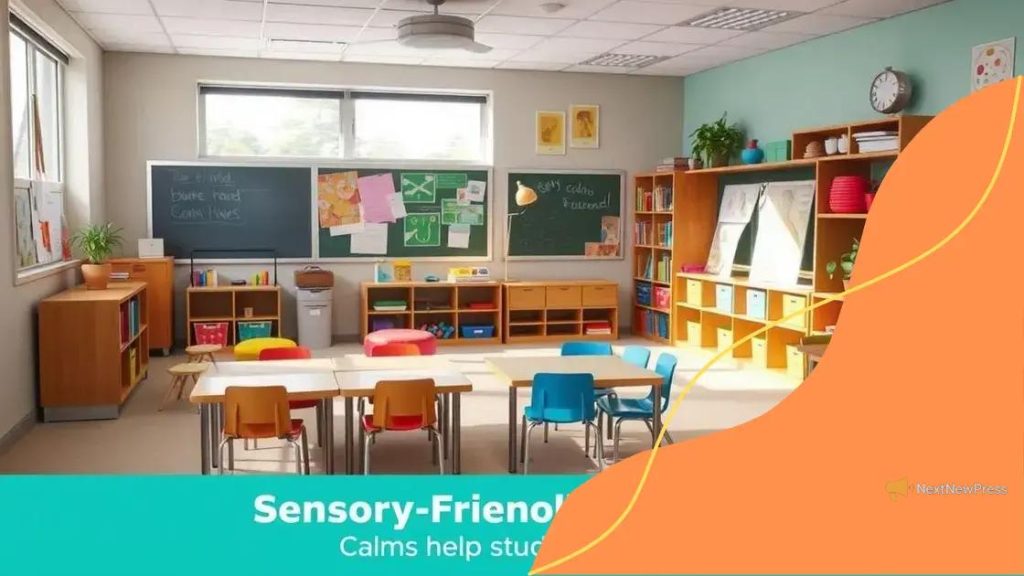Supporting students with sensory sensitivities: key strategies

Supporting students with sensory sensitivities involves creating a sensory-friendly classroom, utilizing specific tools, and engaging families to provide a consistent and supportive learning environment tailored to each student’s needs.
Supporting students with sensory sensitivities is crucial for their success in the classroom. Have you ever thought about how these sensitivities affect learning? Let’s explore practical ways to make a difference.
Understanding sensory sensitivities in students
Understanding sensory sensitivities in students is essential for effective teaching. These sensitivities can affect how students respond to their environments and learn. Some students may react strongly to sounds, lights, or textures that others find normal. Recognizing these differences allows educators to support their needs better.
Types of Sensory Sensitivities
There are various types of sensory sensitivities that can impact a student’s learning experience:
- Auditory sensitivities: Overreacting to sounds or struggling to focus in noisy environments.
- Visual sensitivities: Discomfort with bright lights or busy visual stimuli, making it hard to concentrate.
- Tactile sensitivities: Aversion to certain textures, which might affect their clothing choices or interactions.
- Olfactory sensitivities: Strong reactions to smells that can cause distractions or discomfort.
Being aware of these sensitivities can help create a more inclusive classroom. For example, students with auditory sensitivities might benefit from seating arrangements that minimize noise. Similarly, understanding tactile sensitivities can guide choices regarding classroom materials and activities.
The Role of Educators
Teachers play a crucial role in understanding sensory sensitivities. By observing students, educators can identify specific triggers and responses. Open communication with students about their preferences can also foster a supportive environment.
For instance, implementing sensory breaks during class can help students recharge. Environments that allow for varying activities can also benefit sensitive students. Working alongside parents can enhance these strategies, ensuring a consistent approach in supporting these students.
Common triggers and their impact
Common triggers for students with sensory sensitivities can vary widely, yet understanding them is crucial for effective classroom management. These triggers can lead to increased stress and anxiety, impacting a student’s ability to learn. Some students may react adversely to loud noises, bright lights, or even particular textures. Identifying these triggers helps create a nurturing environment.
Types of Common Triggers
Several familiar triggers can affect students:
- Noise levels: High volumes, such as conversations or background music, can be overwhelming.
- Lighting: Bright fluorescent lights or strobe effects may cause discomfort or distraction.
- Physical touch: Certain clothing materials or unexpected contact can be unsettling.
- Strong smells: Perfumes, cleaning products, and food odors can be distracting or even distressing.
Each student’s response to these triggers will differ. For some, a noisy classroom can lead to difficulties focusing, while others might become anxious in bright light. Understanding these differences allows educators to implement strategies tailored to each student’s needs.
Impact on Learning and Behavior
The impact of sensory triggers on learning can be significant. When students are overwhelmed, they often struggle to concentrate, participate, or communicate effectively. This disconnect can lead to behavioral issues, as students react to their discomfort in various ways.
Creating a sensory-friendly classroom is essential for helping students thrive. Adjusting noise levels, using softer lighting, and allowing students to wear comfortable clothing can profoundly impact their comfort levels. Building a culture of understanding among students is also vital, enabling them to empathize with one another’s needs.
Strategies for educators to support sensory needs

Strategies for educators to support sensory needs are vital in fostering a nurturing learning environment. Understanding how to create a sensory-friendly space can help students feel more comfortable and engaged in their studies. Implementing simple adjustments can have a powerful impact.
Environment Adjustments
Creating a supportive environment involves making physical changes in the classroom. Consider the following adjustments:
- Reduce noise levels: Use soft materials for bulletin boards and keep classroom décor minimal to lessen distractions.
- Optimize lighting: Utilize natural light when possible and avoid harsh fluorescent bulbs. Task lighting can also help.
- Designate sensory spaces: Create a calm corner where students can retreat when feeling overwhelmed, complete with stress-relief tools.
These changes can make a significant difference, allowing students to focus better and feel less anxious. Furthermore, involving students in the process of setting up their space can empower them.
Incorporating Sensory Tools
Using sensory tools in the classroom can provide students with the necessary support they need to thrive. Incorporate tools such as:
- Fidget spinners or cubes: These tools can help students stay focused and manage anxiety.
- Noise-canceling headphones: These can be beneficial for students who are sensitive to auditory stimuli.
- Weighted blankets or vests: These can provide comfort and help students feel secure in their environment.
Additionally, allowing students to use these tools helps them learn to manage their sensitivities independently. Educators should remain flexible to accommodate different needs, as each student is unique in their responses.
Enhancing Communication
Clear communication with students is key in understanding their needs. Engage in open discussions about their sensory experiences and preferences. Create an approachable atmosphere where students feel safe sharing their feelings. Educators can also work with parents to gain insights into the student’s specific sensitivities and strategies that work well at home.
By building strong relationships and fostering open communication, educators can make informed decisions that enhance the learning experience for students with sensory needs.
Creating a sensory-friendly classroom
Creating a sensory-friendly classroom is essential for supporting students with sensory sensitivities. A well-designed environment helps students feel safe, comfortable, and focused on learning. By making thoughtful adjustments, educators can foster an inclusive atmosphere that caters to diverse sensory needs.
Physical Space Adjustments
One of the first steps in creating a sensory-friendly classroom is adjusting the physical space. Important changes include:
- Quiet zones: Designate areas in the classroom where students can go to reduce sensory overload. This space should include comfortable seating and calming colors.
- Flexible seating: Provide options like bean bags, stability balls, or floor cushions to allow students to find comfortable positions that suit their needs.
- Natural elements: Incorporate plants or natural light to create a calming atmosphere conducive to learning.
These environment modifications can help students feel more at ease and ready to engage in their learning activities.
Utilizing Sensory Tools
Incorporating sensory tools can further enhance the classroom experience for students. Tools such as:
- Noise-canceling headphones: These can help students who are sensitive to auditory distractions concentrate better.
- Fidget toys: These tools can assist in maintaining focus for students who may need to keep their hands busy.
- Weighted blankets or vests: These can provide comfort and a sense of security during lessons.
Using sensory tools allows students to manage their sensory experiences better. This empowerment can lead to improved focus and participation in classroom activities.
Collaboration and Understanding
Building a community of understanding among students is crucial in a sensory-friendly classroom. Educators can facilitate discussions on sensory sensitivities, encouraging classmates to share their experiences and needs. This creates a supportive atmosphere where difference is respected.
Additionally, teachers can collaborate with parents to gather insights about sensory challenges that students face at home. This partnership can create consistent strategies and help students feel supported both at school and at home.
Engaging families in support efforts
Engaging families in support efforts is a key aspect of helping students with sensory sensitivities. When families are involved, it creates a unified approach to addressing the needs of the child. Open communication and collaboration between educators and families can enhance the student’s learning experience.
Building Strong Communication
Effective communication is vital in engaging families. Teachers should reach out to parents regularly to discuss their child’s progress and any concerns. This can be done through:
- Regular updates: Send newsletters or emails to keep families informed about classroom activities and policies.
- Parent-teacher meetings: Set up times for face-to-face discussions to talk about the child’s sensory needs.
- Surveys: Use surveys to gather information on family experiences and preferences regarding sensory strategies.
By providing various communication methods, families will feel more connected and valued in the educational process.
Involving Families in Sensory Strategies
Families can play an active role in developing sensory strategies. Teachers can invite parents to share successful strategies they implement at home. This involvement can lead to a consistent approach in both settings, making transitions easier for the students. Strategies may include:
- Calming techniques: Parents can practice soothing practices like deep breathing or mindfulness with their children.
- Sensory tools: Families can work with teachers to select effective tools for their children to use at school and home.
- Routine collaboration: Establish routines that both teachers and parents can follow, helping students feel secure.
When families and educators work together, it creates a unified front supporting the child’s needs and helping them thrive.
Encouraging Family Participation
Invite families to participate in school events and workshops that focus on sensory awareness. These gatherings can provide valuable resources and build community. Additionally, sharing success stories between families can motivate others to engage and learn from one another’s experiences.
Creating a welcoming atmosphere where families feel comfortable participating will strengthen the support network for students dealing with sensory sensitivities. Engaging families ultimately leads to better outcomes for students.
FAQ – Frequently Asked Questions about Supporting Students with Sensory Sensitivities
What are sensory sensitivities?
Sensory sensitivities refer to heightened responses to sensory stimuli, like sounds, lights, textures, or smells, affecting how students interact with their environment.
How can I create a sensory-friendly classroom?
You can create a sensory-friendly classroom by reducing noise, optimizing lighting, providing flexible seating, and designating calming spaces for students.
What tools can help students with sensory sensitivities?
Tools such as noise-canceling headphones, fidget toys, and weighted blankets can help students manage their sensory experiences and focus better.
How can families support their children with sensory needs?
Families can support their children by communicating openly with educators, implementing consistent sensory strategies at home, and participating in school activities.





